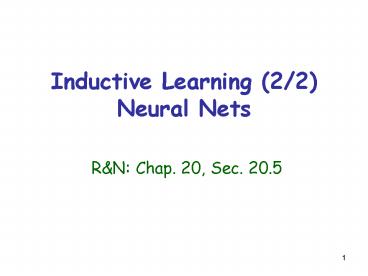Inductive Learning 22 Neural Nets R - PowerPoint PPT Presentation
1 / 22
Title:
Inductive Learning 22 Neural Nets R
Description:
Intros to AI: CS121 and CS221. CS 222: Knowledge Representation. CS 223A: Intro to Robotics. CS 223B: Intro to Computer Vision. CS 224M: Multi-Agent Systems ... – PowerPoint PPT presentation
Number of Views:75
Avg rating:3.0/5.0
Title: Inductive Learning 22 Neural Nets R
1
Inductive Learning (2/2)Neural Nets RN
Chap. 20, Sec. 20.5
2
Function-Learning Formulation
- Goal function f
- Training set (x(i), f(x(i))), i 1,,n
- Inductive inference find a function h that fits
the points well - Same Keep-It-Simple bias
3
Perceptron(The goal function f is a boolean one)
w1 x1 w2 x2 0
4
Perceptron(The goal function f is a boolean one)
?
5
Unit (Neuron)
y g(Si1,,n wi xi)
g(u) 1/1 exp(-a?u)
6
Neural Network
- Network of interconnected neurons
Acyclic (feed-forward) vs. recurrent networks
7
Two-Layer Feed-Forward Neural Network
w1j
w2k
8
Backpropagation (Principle)
- New example y(k) f(x(k))
- f(k) outcome of NN with weights w(k-1) for
inputs x(k) - Error function E(k)(w(k-1)) f(k) y(k)2
- wij(k) wij(k-1) e??E(k)/?wij (w(k)
w(k-1) - e??E) - Backpropagation algorithm Update the weights of
the inputs to the last layer, then the weights of
the inputs to the previous layer, etc.
9
Comments and Issues
- How to choose the size and structure of networks?
- If network is too large, risk of over-fitting
(data caching) - If network is too small, representation may not
be rich enough - Role of representation e.g., learn the concept
of an odd number - Incremental learning
10
Application of NN to Motion Planning(Climbing
Robot)
11
Bretl, 2003
12
Transition
one-step planning
13
Idea Learn Feasibility
- Create a large database of labeled transitions
- Train a NN classifier Q transition ?
feasible, not feasible) - Learning is possible because Shape of a
feasible space is mostly determined by the
equilibrium condition that depends on relatively
few parameters
14
Creation of Database
- Sample transitions at random (by picking 4 holds
at randomwithin robots limb span) - Label each transition feasible or infeasible
by sampling with high time limit - ? over 95 infeasible transitions
- Re-sample around feasibletransitions
- ? 35-65 feasible transitions
- 1 day of computation to create adatabase of
100,000 labeled transitions
15
Training of a NN Classifier
- NN with 9 input units, 100 hidden units, and 1
output unit - Training on 50,000 examples (3 days of
computation) - Validation on the remaining 50,000 examples?
78 accuracy (e 0.22)? 0.003ms average
running time
16
Transition
one-step planning
17
Some Important Achievementsin AI
- Logic reasoning (data bases)
- Search and game playing
- Knowledge-based systems
- Bayesian networks (diagnosis)
- Machine learning and data mining
- Planning and military logistics
- Autonomous robots
18
Un-supervised leaning
Treatment of uncertainty
Efficient constraint satisfaction
19
What Have We Learned?
- Useful methods
- Connection between fields, e.g., control theory,
game theory, operational research - Impact of hardware (chess software ? brute-force
reasoning, case-base reasoning) - Relation between high-level (e.g., search, logic)
and low-level (e.g., neural nets)
representations from pixels to predicates - Beyond learning What concepts to learn?
- What is intelligence? Impact of other aspects of
human nature fear of dying, appreciation for
beauty, self-consciousness, ... - Should AI be limited to information-processing
tasks? - Our methods are better than our understanding
20
What is AI?
- Discipline that systematizes and automates
intellectual tasks to create machines that
More formal and mathematical
21
Some Other AI Classes
- Intros to AI CS121 and CS221
- CS 222 Knowledge Representation
- CS 223A Intro to Robotics
- CS 223B Intro to Computer Vision
- CS 224M Multi-Agent Systems
- CS 224N Natural Language Processing
- CS 225A Experimental Robotics
- CS 227 Reasoning Methods in AI
- CS 228 Probabilistic Models in AI
- CS 229 Machine Learning
- CS 257 Automated Deduction and Its Applications
- CS 323 Common Sense Reasoning in Logic
- CS 324 Computer Science and Game Theory
- CS 326A Motion Planning
- CS 327A Advanced Robotics
- CS 328 Topics in Computer Vision
- CS 329 Topics in AI
22
222
224M
224S
224U
224N
KnowledgeRepresentation
Multi-AgentSystems
Natural Language Processing Speech Recognition
and Synthesis
227
227B
Reasoning Methods in AI
GeneralGame Playing































